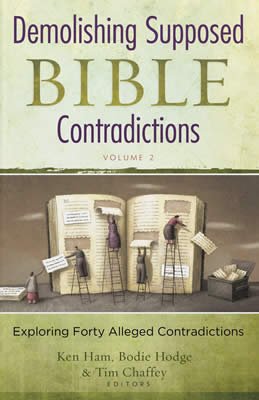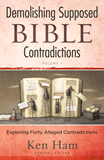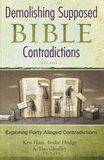
Figuring out the Root of the Matter
When Jesus cursed the fig tree, did it whither immediately or the next day? John Bartlett Jr., AiG–U.S., examines this alleged contradiction.
The “Problem”
The following passages give us some of the context for this supposed contradiction.
And seeing a fig tree by the road, He [Jesus] came to it and found nothing on it but leaves, and said to it, “Let no fruit grow on you ever again!” Immediately the fig tree withered away. (Matthew 21:19)
Now in the morning, as they passed by, they saw the fig tree dried up from the roots. And Peter, remembering, said to Him, “Rabbi, look! The fig tree which You cursed has withered away.” (Mark 11:20–21)
If these passages were speaking figuratively, then we wouldn’t be worried about the apparent contradiction between these two accounts of the Lord’s encounter with a fig tree in Matthew 21:19 and Mark 11:20. Howbeit, we are dealing with a passage in a literal sense.
We know that Jesus literally caused the fig tree to wither. Thus, there seems to be a problem in the timing. At first reading, it appears that the tree withered at once in Matthew, but according to Mark it withered the day after Jesus rebuked it. How could the fig tree wither immediately and on the next day as well?
The Solution
At first, it might seem like Jesus could have told a fig tree to wither on two different occasions, right? Well, given the context, it is most likely that Matthew and Mark were writing about the same occasion—especially because both instances would have had to occur on the same day.
In Matthew 21:17 we read, “Then He left them
[chief priests and the scribes] and went out of the city to Bethany, and He lodged there.
” The very next verses state, “Now in the morning, as He returned to the city, He was hungry. And seeing a fig tree by the road, He came to it and found nothing on it but leaves
” (Matthew 21:18–19). Similarly, Mark recorded, “And Jesus went into Jerusalem and into the temple. So when He had looked around at all things, as the hour was already late, He went out to Bethany with the twelve
” (Mark 11:11). Verse 12 then states, “Now the next day, when they had come out from Bethany, he was hungry. And seeing from afar a fig tree having leaves, He went to see if perhaps He would find something on it.
”
Both passages describe Jesus encountering the fig tree on the day after His triumphal entry into Jerusalem (see Matthew 21:1–11 and Mark 11:1–10). There are at least three plausible solutions to this dilemma, and now that we understand the timing of the event, let’s dig deeper into the wording of both accounts. Take a look at, this parallel passage to Matthew 21:19:
And seeing from afar a fig tree having leaves, He went to see if perhaps He could find something on it. When He came to it, He found nothing but leaves, for it was not the season for figs. In response Jesus said to it, “Let no one eat fruit from you ever again.” And His disciples heard it. (Mark 11:13–14)
I can just imagine the disciples thinking, “That was strange. Jesus should know that figs come later in the season.” Of course, Jesus knew that—He created the fig tree.
Jesus used this opportunity to make an important point. Many scholars believe the fig tree represented Israel, or at least her leaders in Jerusalem, since fruitless fig trees are often used symbolically in reference to judgment (Jeremiah 8:13; Joel 1:7). If this is accurate then Jesus was showing what would soon come to pass as God’s judgment would fall on the nation. Others understand this event as symbolizing that, much like the fig tree’s lack of fruit, you can also recognize followers of Christ by their good fruit, discern hypocrites by their lack of fruit, and false teachers by their bad fruit.
Mark went on to write the following words:
Now in the morning, as they passed by, they saw the fig tree dried up from the roots. And Peter, remembering, said to Him, “Rabbi, look! The fig tree which You cursed has withered away.”
So Jesus answered and said to them, “Have faith in God. For assuredly, I say to you, whoever says to this mountain, ‘Be removed and be cast into the sea,’ and does not doubt in his heart, but believes that those things he says will be done, he will have whatever he says. Therefore I say to you, whatever things you ask when you pray, believe that you receive them, and you will have them. (Mark 11:20–24)
The passage recounts how Peter remembered and said to Jesus that the fig tree had withered to its roots. Matthew accounts for when the tree actually withered (being withered in appearance from a loss of moisture), and the passage in Mark’s Gospel states that Peter took note that the tree had withered all the way to the roots (meaning that the tree had at this point completely shriveled). So, from this perspective, both passages are in agreement.
The other possible solutions are largely based on the variant meanings of two key terms. The first of these possibilities focuses on the word “withered” and is closely related to the previous solution. When Matthew stated that the fig tree withered away, did he mean that it was completely shriveled within minutes or that the process of withering began right away? Matthew 21:20 states, “And when the disciples saw it, they marveled, saying, ‘How did the fig tree wither away so soon?’
” Looking at Mark’s account, we learn that the disciples did not see the withered tree until the next morning. So at first glance, there appears to be a discrepancy, but if this view is right, then Matthew simply wrote about this particular event from a topical approach rather than chronological, while Mark did the opposite.
Another possible solution is based on the notion that “immediately” in Matthew 21:19 is a relative timing word. Although it is primarily used to refer to something that happens within the next few moments after a prior event, it can be used in a more relative sense in certain contexts that would normally require a long period of time. In this case, the withering of a tree would normally become noticeable over the period of weeks or several months. So if the fig tree withered overnight, Matthew’s use of the word “immediate” would make sense.
Conclusion
If you ever doubt the text of scripture, be sure to take the time to dig deeper. By taking one look at these passages, it would be easy to get confused and be discouraged. A more detailed study serves to demonstrate the trustworthiness of God’s Word. Remember, many people are always eager to throw out the Word of God. Don’t be so quick to follow their example. We know that so many passages have proved accurate, so we should give Scripture the benefit of the doubt when we come across a difficult passage.
Demolishing Supposed Bible Contradictions: Volume 2
Recommended Resources

Answers in Genesis is an apologetics ministry, dedicated to helping Christians defend their faith and proclaim the good news of Jesus Christ.
- Customer Service 800.778.3390
- © 2024 Answers in Genesis




